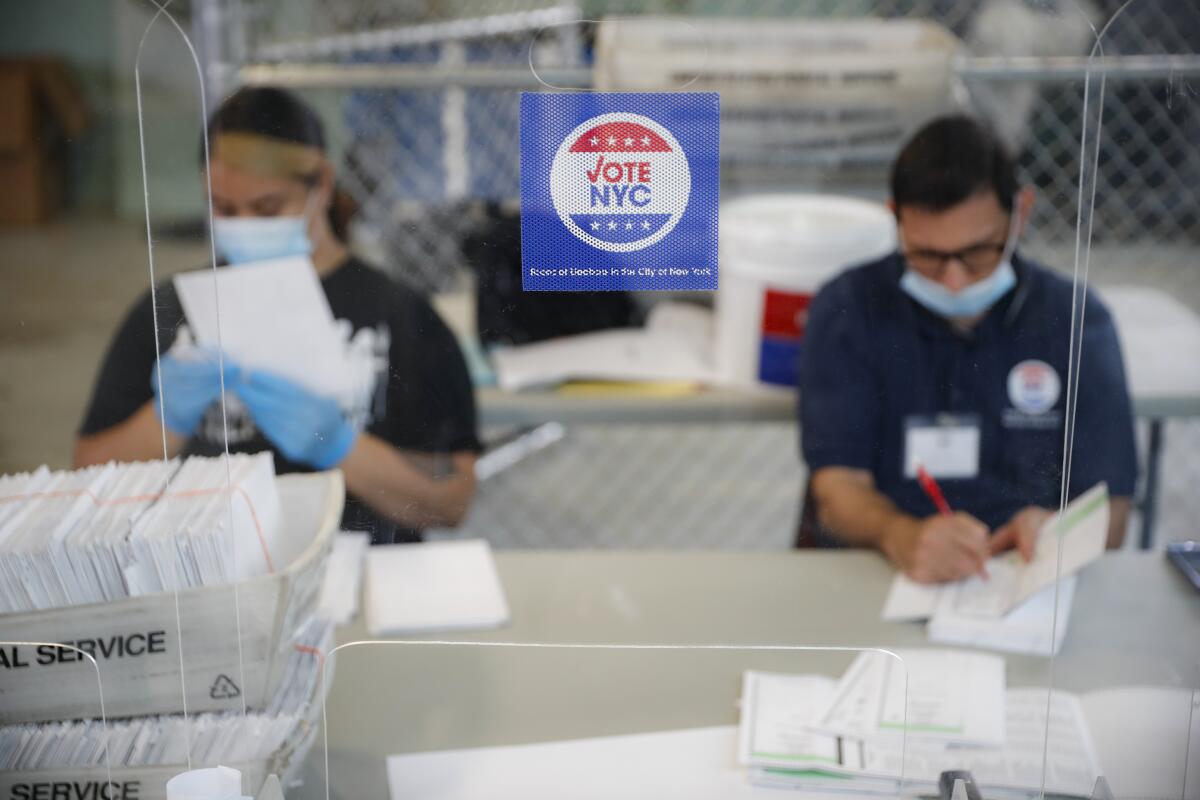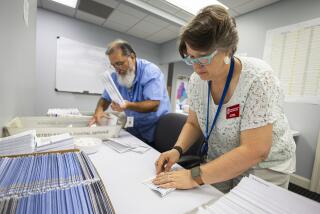Editorial: Six ways to ensure Americans can vote safely amid the pandemic

With only three months to go before the November election and the coronavirus pandemic still a threat to public health, Congress and the states must do much more to help Americans exercise their right to vote without placing themselves in danger.
Several states have responded to the pandemic by making it easier to vote by mail, but that option needs be made even more available. States also need adequate personnel and equipment to ensure that votes cast by mail are fully counted and that voters whose ballots are rejected have the opportunity to appeal, while still providing sanitized polling stations and in-person voting for those who need that option. Finally, a public education campaign is necessary to counter President Trump’s cynical suggestion that a delay in completing the vote tallies and declaring a winner is evidence of fraud.
Here are some specific steps that must be taken — by government and by you — to ensure that the Nov. 3 election lives up to the nation’s democratic ideals.Provide more aid for state and local election systems.
In March, Congress included $400 million for state election systems in a coronavirus stimulus package. But that sum falls short of what will be required for states — especially those with limited experience in voting by mail — to efficiently process ballots. The Democratic-controlled House passed a new relief bill in May that would give state election systems $3.6 billion to respond to the pandemic, a sum much closer to estimates by outside election experts of what is required. It also would spell out procedures for states to follow to make voting easier.
Trump has falsely and recklessly accused congressional Democrats of seeking to “increase voter fraud.” But even some Republicans who have recognized the importance of helping state election systems weather the pandemic are resistant to providing detailed instructions to the states on how to conduct their elections during this emergency.
For example, there are legitimate concerns, not confined to Republicans, about so-called “ballot harvesting,” the collection and delivery of multiple ballots by private citizens or party activists. The House-passed bill includes language saying that states can’t put limits on how many ballots a “designated person” may turn in. An acceptable compromise would be to provide generous federal aid to state election systems to deal with the pandemic without imposing such a requirement.Expand early voting.
Some citizens will want to vote in person even if there is an opportunity for voting by mail. They include voters who are disabled and those who may need language assistance to vote. The larger the window for early voting, the smaller the risk that polling places will be congested and dangerous for elderly voters and others who are especially vulnerable to severe cases of COVID-19.Ensure that the post office can deliver absentee ballots expeditiously.
There are legitimate fears that the Trump administration might hobble or starve the U.S. Postal Service to impede voting by mail. In fact, Trump seemed to confirm those concerns Thursday when he said he opposed a bailout for the post office because the money would be used to handle “millions and millions of ballots.” The post office must be adequately funded to respond to the pandemic, and ballots should be sent out as first-class mail if that means they will be delivered sooner.Allow a grace period for mailed ballots.
As an additional safeguard, states and counties that require absentee ballots to be received or be postmarked by election day should allow additional time for such ballots to arrive. Sign up younger poll workers.
Officials should encourage young people to serve as poll workers, a function frequently performed by retired people who may be fearful this year of taking part because of the virus. (In Los Angeles County, high school students can serve as poll workers.)Take the time necessary for an accurate count.
Trump has insinuated that there is something suspicious about vote counts that are not completed on election night. Last month he tweeted: “Must know Election results on the night of the Election, not days, months, or even years later!”
But elections that aren’t resolved on election night aren’t inherently suspicious. Election officials, and especially Republican secretaries of state, should publicly contest Trump’s conspiracy theory and explain why the special circumstances of this year’s election are likely to leave many races undecided on election night without any sinister implications.
In the case of the presidential election, Congress should provide states with additional time to process ballots by enacting legislation proposed by Sen. Marco Rubio (R-Fla.). Rubio’s bill would change from Dec. 8 to Jan. 1 the so-called “safe harbor” date by which states must resolve disputes over election results in order to have Congress accept them as conclusive. The bill also would move the date on which the electoral college casts votes from Dec. 14 to Jan. 2. (The bill would have no effect on the date of the inauguration, which is set by the Constitution.)
At the same time, states can and should take steps to expedite the counting of the ballots that arrive early. For example, California Gov. Gavin Newsom has signed legislation allowing county election officials to start processing mail-in ballots 29 days before the election. But in this extraordinary — and extraordinarily important — election year, an accurate tabulation of votes is more important than a speedy one.
More to Read
A cure for the common opinion
Get thought-provoking perspectives with our weekly newsletter.
You may occasionally receive promotional content from the Los Angeles Times.










